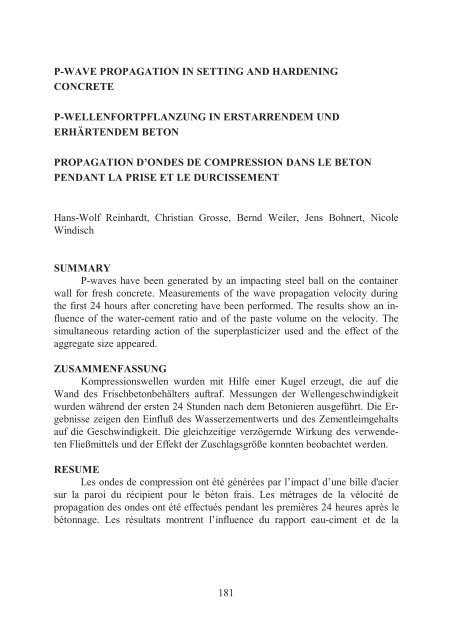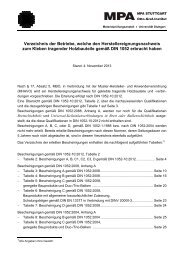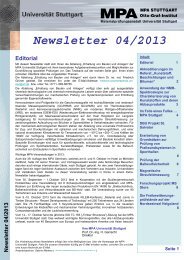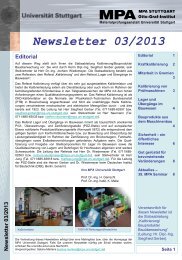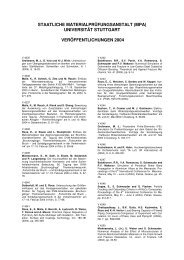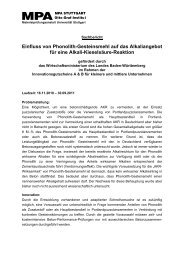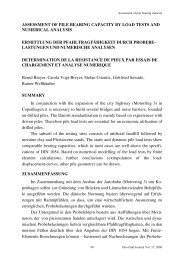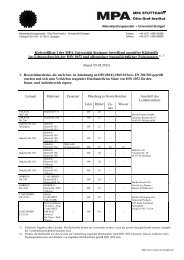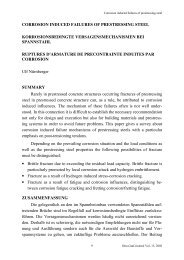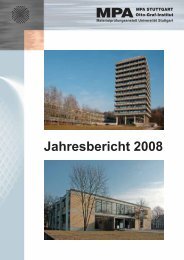p-wave propagation in setting and hardening concrete
p-wave propagation in setting and hardening concrete
p-wave propagation in setting and hardening concrete
You also want an ePaper? Increase the reach of your titles
YUMPU automatically turns print PDFs into web optimized ePapers that Google loves.
P-WAVE PROPAGATION IN SETTING AND HARDENING<br />
CONCRETE<br />
P-WELLENFORTPFLANZUNG IN ERSTARRENDEM UND<br />
ERHÄRTENDEM BETON<br />
PROPAGATION D’ONDES DE COMPRESSION DANS LE BETON<br />
PENDANT LA PRISE ET LE DURCISSEMENT<br />
Hans-Wolf Re<strong>in</strong>hardt, Christian Grosse, Bernd Weiler, Jens Bohnert, Nicole<br />
W<strong>in</strong>disch<br />
SUMMARY<br />
P-<strong>wave</strong>s have been generated by an impact<strong>in</strong>g steel ball on the conta<strong>in</strong>er<br />
wall for fresh <strong>concrete</strong>. Measurements of the <strong>wave</strong> <strong>propagation</strong> velocity dur<strong>in</strong>g<br />
the first 24 hours after concret<strong>in</strong>g have been performed. The results show an <strong>in</strong>fluence<br />
of the water-cement ratio <strong>and</strong> of the paste volume on the velocity. The<br />
simultaneous retard<strong>in</strong>g action of the superplasticizer used <strong>and</strong> the effect of the<br />
aggregate size appeared.<br />
ZUSAMMENFASSUNG<br />
Kompressionswellen wurden mit Hilfe e<strong>in</strong>er Kugel erzeugt, die auf die<br />
W<strong>and</strong> des Frischbetonbehälters auftraf. Messungen der Wellengeschw<strong>in</strong>digkeit<br />
wurden während der ersten 24 Stunden nach dem Betonieren ausgeführt. Die Ergebnisse<br />
zeigen den E<strong>in</strong>fluß des Wasserzementwerts und des Zementleimgehalts<br />
auf die Geschw<strong>in</strong>digkeit. Die gleichzeitige verzögernde Wirkung des verwendeten<br />
Fließmittels und der Effekt der Zuschlagsgröße konnten beobachtet werden.<br />
RESUME<br />
Les ondes de compression ont été générées par l’impact d’une bille d'acier<br />
sur la paroi du récipient pour le béton frais. Les métrages de la vélocité de<br />
<strong>propagation</strong> des ondes ont été effectués pendant les premières 24 heures après le<br />
bétonnage. Les résultats montrent l’<strong>in</strong>fluence du rapport eau-ciment et de la<br />
181
teneur en pâte de ciment sur la vélocité. L’effet retardateur simultané du<br />
superfluidifiant employé et l'<strong>in</strong>fluence de la taille des agrégats ont été observés.<br />
KEYWORDS: <strong>concrete</strong>, sett<strong>in</strong>g, harden<strong>in</strong>g, ultrasound, <strong>wave</strong> <strong>propagation</strong>, fresh<br />
<strong>concrete</strong>, P-<strong>wave</strong><br />
1 INTRODUCTION<br />
In 1994, results on ultrasonic measurements on fresh <strong>and</strong> harden<strong>in</strong>g <strong>concrete</strong><br />
were reported [Grosse & Re<strong>in</strong>hardt 1994]. The variables of those tests were<br />
the water-cement ratio, the type of cement <strong>and</strong> the addition of retarders. It turned<br />
out that all variables had a specific <strong>in</strong>fluence on the <strong>propagation</strong> velocity of the<br />
compressional <strong>wave</strong>, on the transmitted energy, <strong>and</strong> on the frequency spectrum of<br />
the transmitted <strong>wave</strong>.<br />
The <strong>in</strong>vestigations have now been extended to <strong>concrete</strong>s with various water-cement<br />
ratios at the same paste content, with various aggregate sizes, a highperformance<br />
<strong>concrete</strong> <strong>and</strong> a self-compact<strong>in</strong>g <strong>concrete</strong>. Furthermore, the test<strong>in</strong>g<br />
device has been improved.<br />
2 TEST SET-UP<br />
An impact<strong>in</strong>g steel ball with 4 mm diameter was used as <strong>wave</strong> generator.<br />
The ball was accelerated by compressed air <strong>and</strong> hit the PMMA conta<strong>in</strong>er wall <strong>in</strong><br />
the center with a velocity of about 11.2 m/s. The pulse had a duration of about 10<br />
μs <strong>and</strong> a frequency range up to 100 kHz. The pulse was measured by a broadl<strong>and</strong><br />
piezo transducer which was mounted to the PMMA wall close to the po<strong>in</strong>t of impact.<br />
An equal broadl<strong>and</strong> receiver was mounted to the opposite wall of the conta<strong>in</strong>er<br />
for the transmitted signal. The clear distance from wall to wall was 70 mm.<br />
Both PMMA walls were clamped between coated plywood plates, but the contact<br />
between PMMA <strong>and</strong> plywood was very soft,due to a rubber sealant. By this<br />
182
measure, it was possible to suppress <strong>wave</strong>s go<strong>in</strong>g through the walls faster than<br />
through the fresh <strong>concrete</strong>. Fig. 1 shows a scheme of the conta<strong>in</strong>er. The signals<br />
were preamplified <strong>and</strong> recorded with a personal computer at a sampl<strong>in</strong>g rate of 5<br />
MHz. Software for data process<strong>in</strong>g able to evaluate the signals with respect to P<strong>wave</strong><br />
<strong>propagation</strong> velocity, transmitted energy <strong>and</strong> frequency content was available.<br />
However this paper is conf<strong>in</strong>ed to <strong>wave</strong> <strong>propagation</strong> velocity.<br />
Fig. 1 Test set-up for US measurements on harden<strong>in</strong>g <strong>concrete</strong> conta<strong>in</strong>er.<br />
Length = 160 mm, depth = 200 mm, width = 70 mm<br />
3 CONCRETES TESTED<br />
The reference mixture consisted of Portl<strong>and</strong> cement CEM I 32.5 R,<br />
rounded natural quartzitic aggregates with 8 mm maximum aggregate size <strong>and</strong> a<br />
water-cement-ratio of 0.55. Keep<strong>in</strong>g the paste content the same, the water-cement<br />
183
atio was changed to 0.45 <strong>and</strong> 0.40. Then, the aggregate size was changed to 2<br />
<strong>and</strong> 16 mm <strong>and</strong> the water-cement ratio was kept at 0.55. The paste content varied<br />
because workability should be approx. the same. F<strong>in</strong>ally, a high-performance<br />
<strong>concrete</strong> <strong>and</strong> a self-compact<strong>in</strong>g <strong>concrete</strong> were designed. Table 1 shows the mixtures.<br />
The paste content was calculated assum<strong>in</strong>g the densities of cement <strong>and</strong> silica<br />
fume to be 3100 kg/m 3 <strong>and</strong> 2300 kg/m 3 ,resp.<br />
Table 1. Mixtures tested<br />
Component Unit Mixture code<br />
55/8 45/8 40/8 55/2 55/16 33/8H 45/8F<br />
Cement kg/m 3 320 360 386 400 320 480 360<br />
Water 1) -cement ratio - 0.55 0.45 0.40 0.55 0.55 0.33 0.45<br />
Max. aggregate size mm 8 8 8 2 16 8 8<br />
Silica fume 2)<br />
kg/m 3<br />
- - - - - 30 -<br />
Superplasticizer kg/m 3<br />
- - - - - 13 5.4<br />
Paste volume l/m 3<br />
279 278 279 349 279 339 283<br />
1)<br />
Water of silica slurry <strong>and</strong> superplasticizer <strong>in</strong>cluded<br />
2)<br />
Dry mass<br />
4 VELOCITY OF WAVE PROPAGATION<br />
4.1 Results<br />
The <strong>propagation</strong> velocity of the P-<strong>wave</strong> vp is shown as function of <strong>concrete</strong><br />
age<strong>in</strong>Figs.2to4.<br />
184
v p [m/s]<br />
4500<br />
4000<br />
3500<br />
3000<br />
2500<br />
2000<br />
1500<br />
1000<br />
500<br />
0<br />
0 120 240 360 480 600 720 840 960 1080 1200 1320 1440<br />
Fig. 2 Velocity of P-<strong>wave</strong> vs. <strong>concrete</strong> age <strong>and</strong> different water-cement ratios<br />
v p [m/s]<br />
4500<br />
4000<br />
3500<br />
3000<br />
2500<br />
2000<br />
1500<br />
1000<br />
500<br />
Age [m<strong>in</strong>]<br />
185<br />
55/8<br />
45/8<br />
40/8<br />
55/8<br />
55/16<br />
55/2<br />
0<br />
0 120 240 360 480 600 720 840 960 1080 1200 1320 1440<br />
Age [m<strong>in</strong>]
Fig. 3 Velocity of P-<strong>wave</strong> vs. <strong>concrete</strong> age <strong>and</strong> vary<strong>in</strong>g aggregate size<br />
v p [m/s]<br />
4500<br />
4000<br />
3500<br />
3000<br />
2500<br />
2000<br />
1500<br />
1000<br />
500<br />
0<br />
0 120 240 360 480 600 720 840 960 1080 1200 1320 1440<br />
Age [m<strong>in</strong>]<br />
Fig. 4 Velocity of P-<strong>wave</strong> vs. <strong>concrete</strong> age for three mixes<br />
The development of the P-<strong>wave</strong> velocity follows the same pattern as already<br />
reported [van der W<strong>in</strong>den, 1990; Grosse & Re<strong>in</strong>hardt, 1994; Re<strong>in</strong>hardt &<br />
Grosse, 1996]. Dur<strong>in</strong>g the fresh <strong>concrete</strong> state, the velocities are rather low <strong>and</strong><br />
amount to 250 to 500 m/s. These velocities are considerably lower than the velocity<br />
of sound <strong>in</strong> water, which is about 1400 m/s. L´Hermite [l´Hermite, 1955]<br />
has expla<strong>in</strong>ed this phenomenon by assum<strong>in</strong>g oscillations between the gra<strong>in</strong>s <strong>in</strong> the<br />
paste rather than <strong>wave</strong> <strong>propagation</strong> <strong>in</strong> a cont<strong>in</strong>uum. There is lower velocity <strong>in</strong><br />
<strong>concrete</strong> with a low water-cement ratio (Fig. 2) <strong>and</strong> small aggregate size (Fig. 3).<br />
However, the <strong>concrete</strong> with 16 mm aggregate has a lower velocity <strong>in</strong> the beg<strong>in</strong>n<strong>in</strong>g<br />
than that with 8 mm gra<strong>in</strong> size.<br />
The age with low velocity extends to 120 to 180 m<strong>in</strong>utes for those <strong>concrete</strong>s<br />
which do not conta<strong>in</strong> superplasticizer. The lower the water-cement ratio,<br />
the shorter is the period with low <strong>wave</strong> velocity. This effect may be attributed to<br />
the shorter distance of cement particles <strong>in</strong> a paste with low water-cement ratio<br />
186<br />
45/8<br />
33/8H<br />
45/8F
<strong>and</strong> the early development of calcium hydroxide <strong>and</strong> trisulfate, which may cause a<br />
weak contact between the particles. The high-performance <strong>and</strong> the selfcompact<strong>in</strong>g<br />
<strong>concrete</strong> show the low velocity period up to about 360 m<strong>in</strong>utes. This<br />
is due to the retard<strong>in</strong>g effect of the lignosulfonate superplasticizer.<br />
Figs. 2 to 4 show a steep <strong>in</strong>crease of the velocity after the first stage. Irrespective<br />
of the water-cement ratio, the velocity <strong>in</strong>creases to about 2500 m/s almost<br />
directly proportionally to the <strong>concrete</strong> age. Thereafter, the <strong>in</strong>crease is slower<br />
<strong>and</strong> reaches about 4000 m/s after 24 hours. A similar behaviour is shown by <strong>concrete</strong><br />
with 8 <strong>and</strong> 16 mm aggregate size. The high-performance <strong>concrete</strong> <strong>and</strong> selfcompact<strong>in</strong>g<br />
<strong>concrete</strong> develop faster <strong>in</strong> the second stage <strong>and</strong> reach the normal<br />
<strong>concrete</strong> at the <strong>concrete</strong> age of 800 m<strong>in</strong>utes. Opposite to all other <strong>concrete</strong>s, the<br />
<strong>concrete</strong> with 2 mm aggregate size starts at the lowest velocity <strong>and</strong> develops<br />
rather smoothly from 2 to 22 hours. It always shows a lower velocity than other<br />
<strong>concrete</strong>s.<br />
4.2 Discussion<br />
The earlier results [Grosse & Re<strong>in</strong>hardt, 1994] showed a clear dependence<br />
of P-<strong>wave</strong> velocity on water-cement ratio dur<strong>in</strong>g the second stage, i.e. between<br />
120 <strong>and</strong> 500 m<strong>in</strong>utes. The lower the water-cement ratio the faster was the velocity<br />
development. Fig. 2 does not show such an <strong>in</strong>fluence. The difference between<br />
the two test series is that the series of 1994 had a variation of water-cement ratio<br />
<strong>and</strong> paste content whereas the 1996 series kept the paste content constant. The<br />
results of 1996 can be <strong>in</strong>terpreted such that a lower paste content caused a<br />
quicker rise of the <strong>wave</strong> velocity.<br />
This <strong>in</strong>terpretation is consistent with Fig. 3, where the largest paste content<br />
(Mix 55/2) had a lower <strong>in</strong>crease of velocity with age of <strong>concrete</strong>. Unfortunately,<br />
the aggregate size was changed as a second parameter which makes the proof<br />
less valid.<br />
187
This means that a ma<strong>in</strong> parameter which governs the velocity development<br />
is the paste content, <strong>and</strong> the water-cement ratio is only a secondary one. With the<br />
same paste content, the larger aggregate size caused a lower velocity, which is<br />
consistent through the whole test<strong>in</strong>g time.<br />
The test results <strong>in</strong>dicate that the velocity <strong>in</strong> the first stage (2 to 3 hours) is<br />
governed both by paste content <strong>and</strong> water-cement ratio. The lower the paste<br />
content is, the higher the velocity which follows from the 1994 experiments gets.<br />
And the lower the water-cement ratio is, the lower is the velocity. In order to get<br />
a quantitative relationship between these parameters there should be at least two<br />
more test series: one with constant water-cement ratio <strong>and</strong> vary<strong>in</strong>g paste content,<br />
<strong>and</strong> another one with constant paste content <strong>and</strong> vary<strong>in</strong>g aggregate size between 4<br />
<strong>and</strong>32mm.<br />
5 CONCLUSION<br />
The tests have shown that the test<strong>in</strong>g method is well suited for conduct<strong>in</strong>g<br />
<strong>wave</strong> <strong>propagation</strong> experiments on fresh <strong>and</strong> harden<strong>in</strong>g <strong>concrete</strong>.<br />
The results show that two stages of P-<strong>wave</strong> <strong>propagation</strong> development exist:<br />
a first stage up to about 3 hours with a low velocity. There, the velocity is lower<br />
for a low water-cement ratio <strong>and</strong> larger paste volume. A second stage follows up<br />
to about 9 hours, where the water-cement ratio does not show an effect but the<br />
paste volume does.<br />
The retard<strong>in</strong>g action of a superplasticizer on lignosulfonate basis has<br />
shown up very clearly.<br />
6 ACKNOWLEDGEMENT<br />
The assistance by Ms L. Krüger, Mr G. Schmidt, Mr H.M. Kraft <strong>and</strong> Mr H.J.<br />
Köhler is gratefully acknowledged.<br />
188
7 REFERENCES<br />
Grosse, C.U., Re<strong>in</strong>hardt, H.W. (1994) Cont<strong>in</strong>uous ultrasound measurements<br />
dur<strong>in</strong>g sett<strong>in</strong>g <strong>and</strong> harden<strong>in</strong>g of Concrete. Otto Graf Journal 5, pp 76-98<br />
L´Hermite, R. (1955) Idées actuelles sur la technologie du béton. Documentation<br />
TBTP, Paris, pp 193-200<br />
Re<strong>in</strong>hardt, H.W., Grosse, C.U. (1996) Sett<strong>in</strong>g <strong>and</strong> harden<strong>in</strong>g of <strong>concrete</strong> cont<strong>in</strong>uously<br />
monitored by elastic <strong>wave</strong>s. In Bartos, J.P.M., Marrs, D.L., Clel<strong>and</strong>, D.J.<br />
(eds.) Production methods <strong>and</strong> workability of <strong>concrete</strong>. Chapman & Hall, London,<br />
pp 415-425<br />
van der W<strong>in</strong>den, N.G.B. (1990) Ultrasonic measurement for sett<strong>in</strong>g control of<br />
<strong>concrete</strong>. In Re<strong>in</strong>hardt, H.W. (ed.) Test<strong>in</strong>g dur<strong>in</strong>g <strong>concrete</strong> construction, Chapman<br />
& Hall, London, pp 122-137<br />
189


